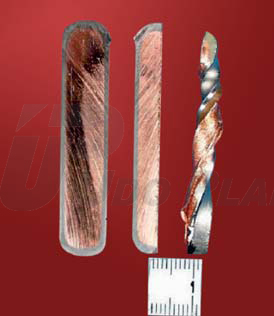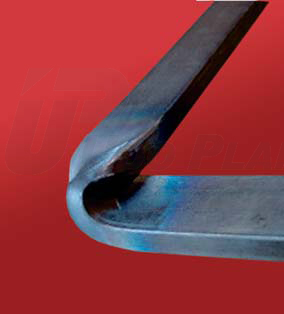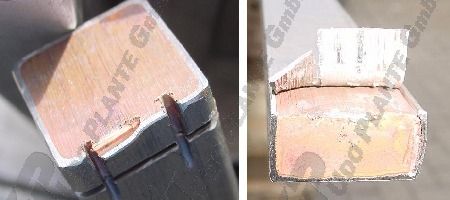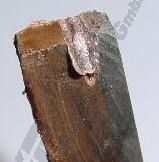Torsion test
The quality of clad materials can be demonstrated with a torsion test,. During this test strips of the material are taken out of the bond zone and twisted around their own axis several times. Clad materials of high quality must not demonstrate any separation of material after the test. TiCu Clad® is a metallurgical clad material of high quality where no impairment of the bonding materials will occur.


Based on the results of the torsion test, TiCu Clad® can even be used with relatively small bending radii. Both cold and hot bendings can be optimally carried out.
Thermal shock test
During the test process, a sample is annealed at a temperature of 520°C for a period of one hour and then subject to water quenching in a basin. This process is repeated up to forty times.
The tests of TiCu Clad® do not show any impairment regarding quality of the metallurgical bond.
As a result, the clad material bars can be directly coated with iridium, platinum or mixed oxides, since this process requires thermal treatment with many cycles at high temperatures.
Ultrasonic testing
The ultrasonic testing has been successfully used as a means of quality control in the recent years. Certain types of defects such as cracks or adhesion problems can be detected due to a higher efficiency of the testing techniques. The ultra sound immediately provides information on the characteristics of the bond.
The sound beam of the ultrasound propagates like light due to the quasi-optical characteristics.
Diffraction phenomena only then occurs when the obstacles causing them are the same size as the waves. Ultrasonic waves are hardly absorbed by metals. The reflection characteristic of sound waves appearing at interfaces as well as at defects, are investigated.
A voltage drop is not to be expected due to the excellent metallurgical bond of TiCu Clad®.
Split test
The so-called split test is a fast and proven method to an overall quality test.
Positive result Negative result
The purpose of the split test is to try to separate the titanium layer from the copper core using a small hammer and a chisel.
A high-quality metallurgical bond deforms, but the titanium layer does not separate from the copper core.




